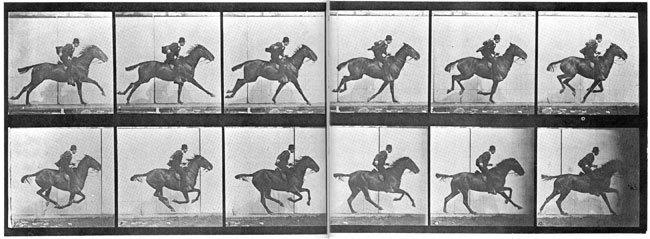Museum Animal Displays Don’t Walk the Walk

Lions, horses, cats and dogs all walk in basically the same way, but nearly half of all depictions of how four-legged animals walk are inaccurate, including illustrations in some natural history museums and veterinary anatomy textbooks, a new study finds.
That's despite the fact that the correct walking behavior of quadrupeds, especially horses, was captured and described in classic motion picture images by photographer Eadweard Muybridge that were published more than 120 years ago.
The actual sequence for the feet of walking quadrupeds as they strike the ground is first the left-hind, then the left-fore, then right-hind and finally the right-fore. This pattern maximizes the stability of four-legged animals, so they always have at least three feet on the ground while walking. Animals differ from one another only in the timing of that stepping.
Universal problem
The study involved an analysis of 307 depictions of quadrupeds' gait by biological physicist Gábor Horváth of Eötvös University in Hungary, his student Adelinda Csapó and others.
Here are the error rates Csapó, Horváth and their colleagues were surprised to find:
- 63.6 percent in animal anatomy books.
- 50 percent for quadruped toys.
- 43.1 percent in taxidermy catalogs.
- 41.1 percent in natural history museums.
- 46.6 percent overall for all 307 walking illustrations and other depictions.
Sources for the analyzed depictions included photographs from exhibitions and storerooms of natural history museums in Hungary, Norway, Finland and Vienna; Web sites of some natural history museums and schools in the United States and elsewhere; Web sites of some animal toy model producers; textbooks of veterinary anatomy and drawing schools; and three taxidermy catalogs.
Get the world’s most fascinating discoveries delivered straight to your inbox.
The nearly 50 percent error rate seems to be a world average, and universal, Horváth told LiveScience.
"In my opinion, these errors should be corrected in the future, if the experts concerned (taxidermists, anatomy book illustrators, toy designers) want to remain scientifically correct," Horváth said. "A museum of natural history, for example, is blamed, if the walking depictions of its quadrupeds exhibited are scientifically, biomechanically wrong. Such a museum seems to exist/remain in the pre-Muybridgian era."
Horváth and his colleagues suspect carelessness and ignorance are the causes of some of these errors. "The rapid distribution of these errors can even be promoted by the Internet, too," the authors wrote in the Jan. 27 issue of the journal Current Biology.
Model horses — often depicted mid-step — would fall over less if they were presented according to the correct footfall formula, he said.
Hollywood does well
Horváth noted one major exception to his findings: Hollywood movies such as "Jurassic Park" and "The Lord of the Rings" generally do get the walking of dinosaurs, elephants, and other fantastic, four-legged creatures just right.
That's because they often rely behind the scenes on experts in biomechanics and animal locomotion, he said.
Horváth first was inspired to study the gait of quadrupeds in the 1970s when he was in secondary school in Hungary. He began to notice that the majority of the gait depictions in a book he read were wrong. Then 30 years later while teaching at Eötvös, he saw that the error rate was just as high, so he enlisted his students and colleagues to help him systematically survey walking depictions.
- Video — See How Cats Walk and Stalk
- Walk This Way: The Amazing Complexity of Getting Around
- Animations Reveal How Dinosaurs Might Have Walked
Robin Lloyd was a senior editor at Space.com and Live Science from 2007 to 2009. She holds a B.A. degree in sociology from Smith College and a Ph.D. and M.A. degree in sociology from the University of California at Santa Barbara. She is currently a freelance science writer based in New York City and a contributing editor at Scientific American, as well as an adjunct professor at New York University's Science, Health and Environmental Reporting Program.

